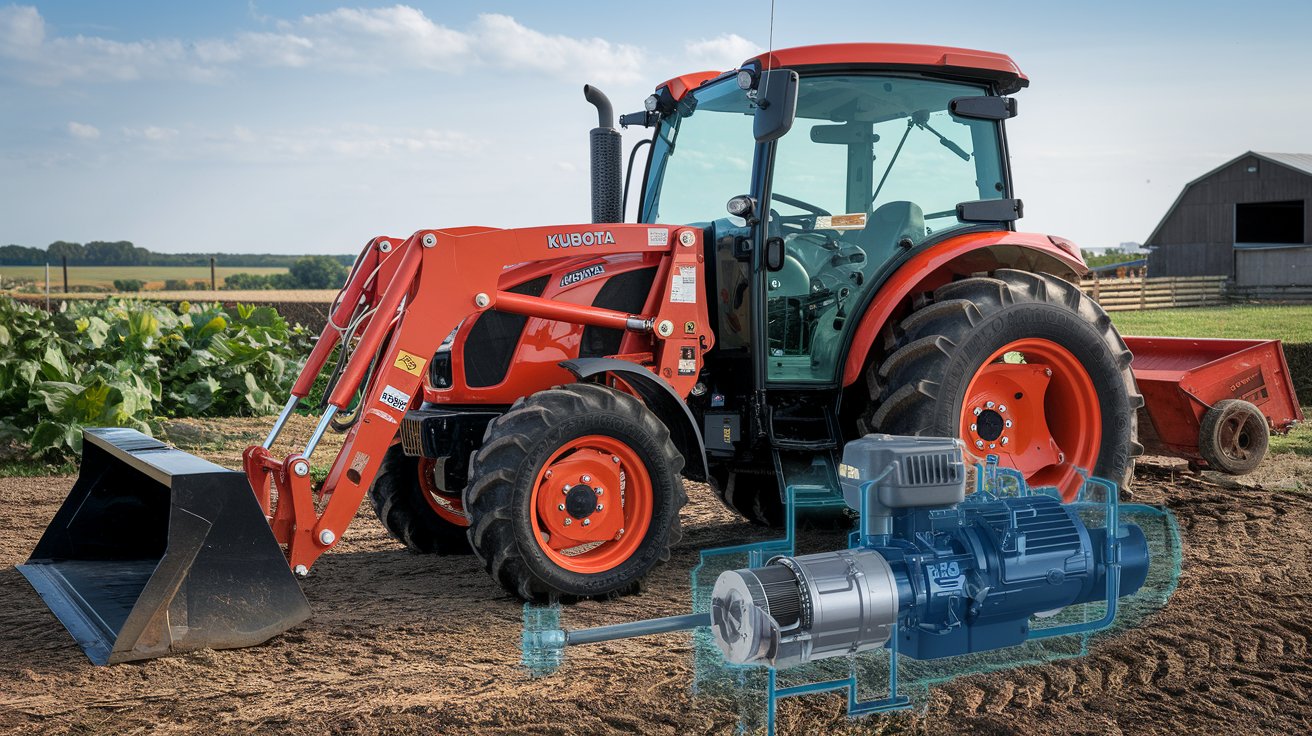Kubota’s hydrostatic transmission systems have revolutionized modern farming and construction, offering unmatched ease of operation and precise control. However, like any sophisticated machinery, they can face challenges that disrupt their smooth functioning. If you’ve noticed your Kubota isn’t performing as seamlessly as it used to, understanding the common hydrostatic transmission problems and how to address them is essential.
This guide provides an in-depth look into Kubota hydrostatic transmission problems, their causes, and solutions, helping you keep your equipment in top shape.
Understanding Kubota’s Hydrostatic Transmission
Kubota’s hydrostatic transmission (HST) systems are a cornerstone of their machinery, renowned for their reliability and ease of use. But what makes this system unique?
What is a Hydrostatic Transmission?
A hydrostatic transmission uses hydraulic fluid to transfer power from the engine to the wheels. Unlike mechanical transmissions, it relies on a pump and motor system, eliminating the need for gears. This design offers smooth, continuous speed control.
Benefits of Hydrostatic Systems in Kubota Machines
- Precision Control: Adjust speed effortlessly without clutching or shifting gears.
- Efficiency: Ideal for tasks requiring variable speeds, such as mowing or tilling.
- Durability: Hydrostatic systems are designed for long-lasting performance with proper maintenance.
Common Applications in Kubota Equipment
Kubota integrates hydrostatic transmission systems into various equipment types, including:
- Tractors: For precision in plowing, mowing, and hauling.
- Utility Vehicles (UTVs): Ensuring smooth rides over rugged terrain.
- Loaders: Offering seamless speed adjustments for heavy-duty tasks.
Signs of Hydrostatic Transmission Problems
Recognizing early warning signs of hydrostatic transmission issues can prevent costly repairs and downtime. Here are common symptoms to watch out for:
1. Unusual Noises During Operation
- Grinding, whining, or knocking sounds may indicate issues with the hydraulic pump or motor.
- Causes could include worn-out components, low fluid levels, or contaminated oil.
2. Loss of Power or Sluggish Performance
- Difficulty accelerating or reduced torque may signal a drop in hydraulic pressure.
- Possible culprits include fluid leaks, clogged filters, or worn seals.
3. Difficulty in Changing Directions
- If your Kubota struggles to switch between forward and reverse, it could point to mechanical wear or insufficient hydraulic pressure.
4. Overheating Issues
- Overheating is a common problem, often caused by overworked components or poor ventilation.
- Check for blockages in the cooling system or degraded hydraulic fluid.
Diagnosing Hydrostatic System Issues
Proper diagnosis is key to resolving hydrostatic transmission problems. Below are step-by-step methods to identify and address the root cause.
1. Visual Inspection Techniques
- Inspect hoses and connections for leaks, cracks, or wear.
- Examine the hydraulic pump and motor for visible damage or unusual wear patterns.
- Look for loose fittings or damaged seals that might be contributing to fluid loss.
2. Fluid Level and Quality Checks
Regular maintenance of hydraulic fluid is crucial. Follow these steps:
- Check the fluid level using the dipstick or sight glass. Ensure it meets Kubota’s recommended levels.
- Inspect fluid quality. Signs of contamination include a milky appearance (indicating water) or dark, gritty fluid (indicating debris).
- Replace hydraulic fluid and filters if contamination or degradation is detected.
3. Pressure Testing Methods
Pressure testing is essential to determine if the hydraulic system is functioning at optimal levels:
- Use a hydraulic pressure gauge to measure pump output and system pressure.
- Compare readings to Kubota’s specifications. Low pressure often points to a failing pump, clogged lines, or leaks.
4. Electronic Diagnostic Tools
Modern Kubota machines often feature diagnostic systems:
- Use onboard diagnostic codes or external scanners to identify electrical or sensor-related issues.
- Common fault codes can indicate problems with sensors, solenoids, or actuators within the hydrostatic system.
Preventative Maintenance Tips
Preventing hydrostatic transmission problems starts with regular maintenance. Follow these best practices to ensure your Kubota runs smoothly:
- Hydraulic Fluid: Replace fluid and filters as per the manufacturer’s guidelines. Use only Kubota-approved hydraulic oil.
- Cooling System: Clean cooling fins and ensure adequate airflow to prevent overheating.
- Hose and Seal Checks: Regularly inspect and replace damaged or worn components.
- Proper Usage: Avoid overloading or using your machine for tasks it’s not designed for, which can stress the transmission.
Troubleshooting Table for Quick Reference
| Symptom | Possible Cause | Solution |
| Unusual noises during operation | Low fluid, contaminated oil | Check and refill fluid; replace contaminated oil. |
| Loss of power/sluggish response | Fluid leaks, clogged filters | Inspect for leaks; replace filters. |
| Difficulty changing directions | Worn components, low pressure | Inspect and replace damaged parts; check system pressure. |
| Overheating | Blocked cooling system, poor fluid | Clean cooling fins; replace degraded fluid. |
Common Causes of Hydrostatic Failures
Hydrostatic transmissions rely on the seamless operation of hydraulic components to deliver power efficiently. When issues arise, they’re often rooted in one or more of the following causes:
1. Contaminated Hydraulic Fluid
- Dirt, debris, or water contamination in the hydraulic fluid can clog the system, reduce lubrication, and cause wear on internal components.
- Symptoms: Sluggish performance, jerky movements, or overheating.
2. Worn Pumps or Motors
- Over time, the hydraulic pumps and motors may wear down, reducing efficiency.
- Symptoms: Reduced power output, difficulty in maintaining consistent speed, or complete failure.
3. Damaged Seals and Gaskets
- Leaks in the system due to damaged seals or gaskets can lead to pressure loss and reduced hydraulic efficiency.
- Symptoms: Visible oil leaks, reduced hydraulic power, or irregular operation.
4. Control Valve Malfunctions
- Control valves regulate the flow of hydraulic fluid. If they become clogged or fail, the system can’t operate smoothly.
- Symptoms: Erratic operation, slow response, or inability to change directions properly.
5. Electrical System Faults
- Modern Kubota tractors often have electronic controls integrated with hydrostatic systems. Faulty wiring, sensors, or control modules can disrupt performance.
- Symptoms: Intermittent failure, unresponsive controls, or error codes displayed on the dashboard.
| Cause | Symptoms | Solution |
| Contaminated Fluid | Sluggish performance, jerky movements | Fluid change, system flush |
| Worn Pumps/Motors | Reduced power, inconsistent speed | Component repair/replacement |
| Damaged Seals/Gaskets | Leaks, reduced power | Seal/gasket replacement |
| Control Valve Malfunctions | Erratic operation, slow response | Valve repair/cleaning |
| Electrical Faults | Unresponsive controls, error codes | Electrical diagnostics |
Preventive Maintenance for Smooth Operation
Regular maintenance can significantly reduce the likelihood of hydrostatic transmission problems. Here’s how you can keep your Kubota running like new:
1. Regular Fluid Changes and Top-Ups
- Use manufacturer-recommended hydraulic fluid and adhere to the suggested change intervals.
- Check fluid levels regularly and top up when necessary to avoid cavitation or overheating.
2. Filter Replacement Schedules
- Replace hydraulic filters as per the Kubota service manual to prevent debris from circulating in the system.
- Use OEM filters for best compatibility and performance.
3. Proper Operating Techniques
- Avoid sudden directional changes or overloading the tractor.
- Allow the system to warm up during colder months to ensure smooth fluid flow.
4. Temperature Management
- Overheating can degrade hydraulic fluid and damage components. Monitor operating temperatures and ensure the radiator and cooling fins are clean.
| Maintenance Task | Frequency | Benefits |
| Fluid Changes | Every 200-300 hours | Maintains lubrication, prevents wear |
| Filter Replacements | Every 100-200 hours | Keeps contaminants out of the system |
| Operating Techniques | Daily | Reduces strain on components |
| Temperature Monitoring | Ongoing | Prevents overheating and damage |
Professional Repair Options
When hydrostatic transmission problems persist despite regular maintenance, professional repairs might be necessary. Here are your options:
1. Dealer Service Benefits
- Expertise: Kubota-certified technicians have extensive experience with hydrostatic systems.
- Warranty Coverage: Repairs at authorized dealerships may be covered under warranty, reducing costs.
- Genuine Parts: Access to OEM parts ensures compatibility and longevity.
2. Specialized Hydraulic Repair Shops
- Cost-Effective: These shops often charge less than dealerships.
- Customization: They can offer tailored solutions or upgrades for specific needs.
- Expertise: Skilled technicians with a focus on hydraulic systems can quickly diagnose and repair issues.
3. DIY Repairs: Risks and Considerations
- Advantages: Cost savings and hands-on control.
- Disadvantages: Risk of improper repairs, voiding warranties, or causing further damage.
- Recommended Only For: Experienced individuals with access to the correct tools and manuals.
| Repair Option | Pros | Cons |
| Dealer Service | Expertise, warranty, OEM parts | Higher costs |
| Hydraulic Repair Shops | Cost-effective, customized solutions | May lack access to proprietary parts |
| DIY Repairs | Cost-saving, hands-on control | Risk of damage, voiding warranties |
Upgrading and Improving Hydrostatic Performance
Enhancing your Kubota’s hydrostatic transmission can improve performance and extend its lifespan. Consider these options:
1. Aftermarket Component Options
- High-quality aftermarket pumps, motors, or seals can sometimes offer better performance or durability than OEM parts.
- Ensure compatibility with your specific Kubota model before purchasing.
2. Software Updates for Modern Systems
- Newer Kubota models may have software-controlled hydrostatic systems. Updating firmware can resolve bugs and optimize performance.
- Check with your dealer for available updates.
3. Performance Tuning Possibilities
- Adjusting settings like pressure relief valves or upgrading cooling systems can boost performance.
- Consult professionals to ensure modifications do not void warranties or compromise safety.
| Upgrade Option | Benefits | Considerations |
| Aftermarket Components | Improved durability and performance | Compatibility with Kubota systems |
| Software Updates | Optimized performance, bug fixes | Limited to newer models |
| Performance Tuning | Enhanced power and efficiency | May void warranty, requires expertise |
Conclusion
Kubota’s hydrostatic transmission systems are engineered for durability and precision, but like all machinery, they require proper care. By recognizing the warning signs of hydrostatic transmission problems, conducting regular maintenance, and promptly addressing issues, you can extend the life of your equipment and maintain its optimal performance.
Do you have additional tips or questions about Kubota hydrostatic transmission problems? Share your experiences in the comments—we’d love to hear from you!

